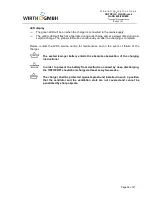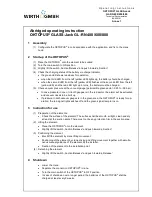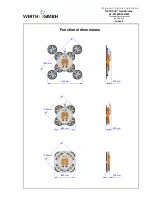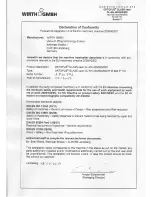
O p e r a t i n g I n s t r u c t i o n s
OKTOPUS
®
GLASS-Jack
GL-RN 400/600/800
Technical Documentation
BA 000 101
Page 24 of 27
4.3 Vacuum system
Vacuum components, which are subject to wear and relevant to safety, must be inspected on a
regular basis. For this purpose:
⇒
Daily
check the components in terms of their correct position and mechanical damages, in
particular:
•
the suction pads (replace suction pad(s) if so),
•
the hoses,
•
the vacuum gauges.
Replace the suction pads and the hoses immediately if these have mechanical
damages (cracks, cuts, etc.)! These damages could lead to a reduced Working
Load Limit of the OKTOPUS
®
.
The vacuum pump runs completely oil-free. The robust design allows a maintenance-free op-
eration.
The infiltration of dust into the vacuum pump is prevented by a filter screwed in into each indi-
vidual suction pad. Therefore, maintenance of the vacuum system is focused on this compo-
nent.
⇒
Slightly lift the OKTOPUS
®
without the load. The filter is in the through-hole to the connec-
tion of the vacuum hose. Dirty filters shall be cleaned.
Fig. 18:
Suction pad
4.3.1 Cleaning the suction pads
Always clean the suction pads prior to every operation of the OKTOPUS
®
, if the suction areas
are soiled (dirt, dust, oil, etc.). Dirt could cause leakages and leave marks on the manipulated
elements.
For cleaning the suction pads we recommend to use water, if necessary add some detergent.
Do not use chemical solvents, petrol, diesel oil or similar in any case.
Never use solvents, petrol or aggressive chemicals for cleaning the suction
pads! Otherwise this may result in damaging the suction pads, which could
endanger the operator as well as others.
Ensure that fluids cannot enter the vacuum system during the cleaning process by positioning
the suction pads or by covering the suction opening. Give the suction pads a sufficient amount
of time to completely dry before operating the OKTOPUS
®
.
Filter (connection vacuum hose)
Suction pad









































